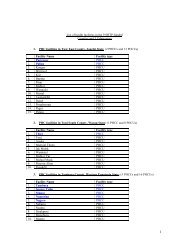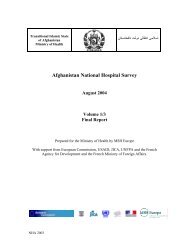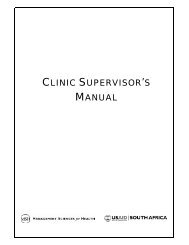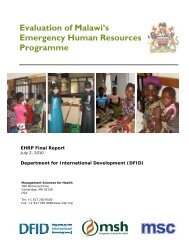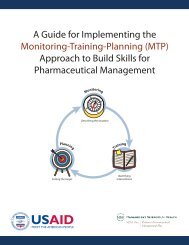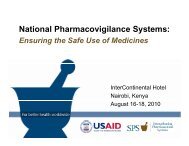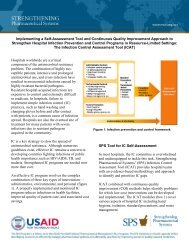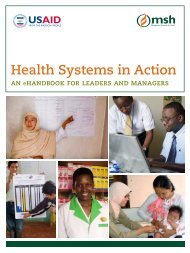India, Survey Data - Management Sciences for Health
India, Survey Data - Management Sciences for Health
India, Survey Data - Management Sciences for Health
You also want an ePaper? Increase the reach of your titles
YUMPU automatically turns print PDFs into web optimized ePapers that Google loves.
About SEAM Country Assessments<br />
In 2000, <strong>Management</strong> <strong>Sciences</strong> <strong>for</strong> <strong>Health</strong> (MSH) received a grant from the Bill & Melinda<br />
Gates Foundation to identify and test innovative approaches to address and ameliorate the lack of<br />
access to essential medicines in developing countries by increasing the participation of the<br />
private sector. Brazil (State of Minas Gerais), Cambodia, El Salvador, Ghana, <strong>India</strong> (State of<br />
Rajasthan), and Tanzania were identified as countries where SEAM would assess the feasibility<br />
of improving access as per the mandate of the Gates Foundation grant. These assessments were<br />
carried out between February and May 2001.As an integral part of the initiative, SEAM sought<br />
out local, private not-<strong>for</strong>-profit, academic, and other research organizations with expertise in<br />
health-services research to collaborate in the assessments, contributing to the adaptation of data<br />
collection instruments, sample selection, data collection, and analysis.<br />
The assessments included facility-based survey questionnaires, simulated client visits, and<br />
patient exit interviews. The present files include the data specifically from the following surveys<br />
and interviews.<br />
1. <strong>Health</strong> facility survey. This includes in<strong>for</strong>mation on operations and supplier per<strong>for</strong>mance,<br />
prices paid and charged, and prescription and dispensing, as well as an inventory review<br />
of tracer items and collection of samples <strong>for</strong> product quality testing. Types of facilities to<br />
be include—<br />
� Medical stores/depots (central, regional, district)<br />
� Public health facilities (clinics and hospital outpatient departments)<br />
� Private not-<strong>for</strong>-profit clinics and hospitals (NGOs, church/mission, other)<br />
� Private <strong>for</strong>-profit facilities (hospitals and clinics)<br />
2. Retail drug outlet survey. This includes in<strong>for</strong>mation on operations and supplier<br />
per<strong>for</strong>mance, an inventory review of tracer items and prices, and samples <strong>for</strong> product<br />
quality testing.<br />
3. Sample of items <strong>for</strong> quality testing. Ten tablets of six to eight items were collected or<br />
purchased from each facility visited.<br />
4. Exit interviews. Where relevant (i.e., in the outpatient department), exit interviews<br />
conducted with patients receiving a prescription.<br />
5. Simulated client. <strong>Data</strong> collectors posing as clients or patients presented symptoms to<br />
dispensers in retail outlets to document prescribing/dispensing behavior.<br />
vii



